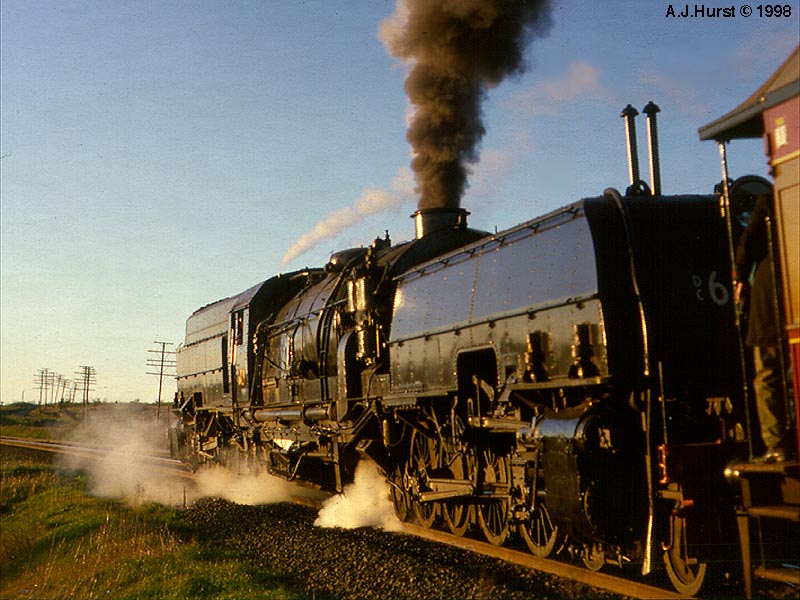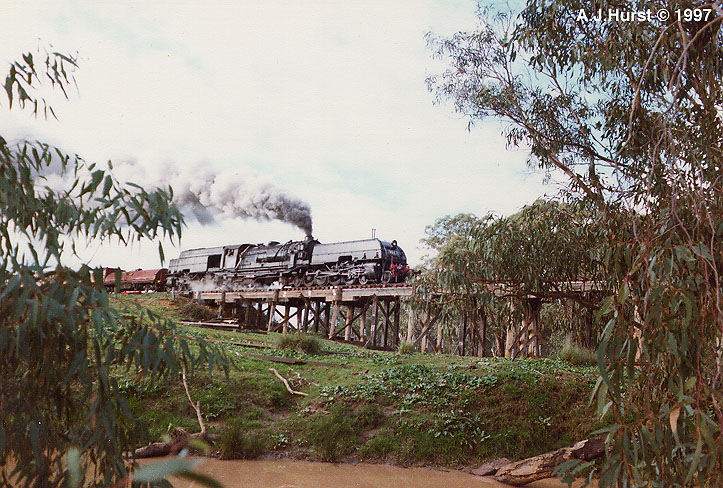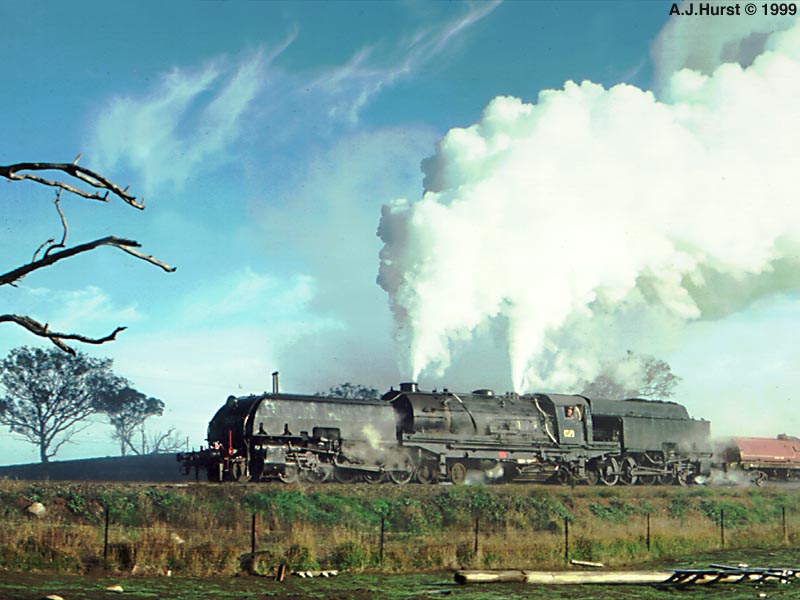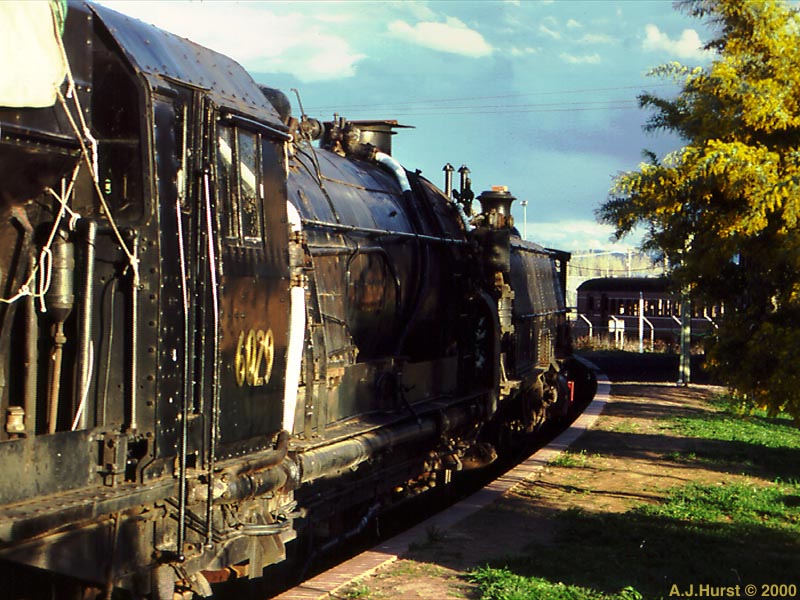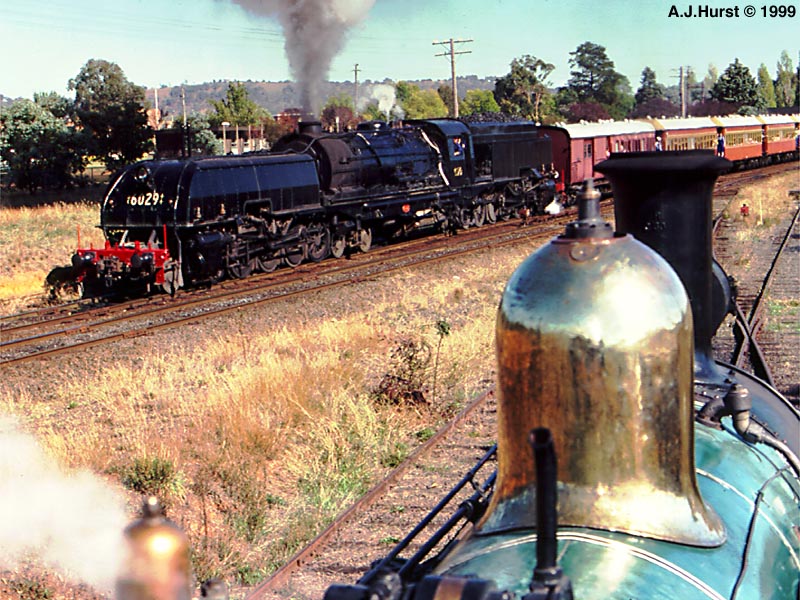|
With
the New South Wales Government Railways needing additional motive power in
the post-war period, orders were placed with Beyer Peacock & Co for 25
freight locomotives of the patented Beyer-Garratt articulated design. This
innovative design provided a powerful steam locomotive consisting of
leading and trailing locomotive units pivoted between a common boiler. Articulation permitted Beyer-Garratt locomotives
to traverse tight curves, while spreading the boiler weight across two
engine units provided a lower axle load and thus permitted use on secondary
/ lightly-laid routes. As the boiler was slung in a frame between the two
articulated locomotive units, a more efficient boiler design was possible
because the firebox depth and boiler diameter was not restricted by the
driving / carrying wheels or other aspects of a conventional steam
locomotive frame.
To meet
traffic demands a further 25 locomotives were subsequently ordered by the
New South Wales Government Railways, however circumstances had changed by
the time deliveries commenced with favour turning to diesel-electric
locomotives. Accordingly the NSWGR sought to curtail the second batch. Following
negotiations with Beyer Peacock & Co, locos 6043 – 6045 were delivered
complete but never assembled, being used as spare parts, locos 6046 &
6047 were delivered incomplete for parts only, while 6048 - 6050 were
cancelled outright.
The AD60
class Beyer-Garratts excelled in NSWGR service, following the elimination
of teething troubles and attention to union concerns. 6029 was among 31
which received modifications during service, including Dual Control (DC) to
allow the locomotive to be driven easily in the ‘reverse’ (bunker-leading)
direction, and increased cylinder diameter for greater tractive effort (‘++’)
and thus was known as a DC++ modified AD60. The DC++ Beyer-Garratts were
often paired on demanding main line freight drags, such as the Fassifern
Colliery run which required 1,200 coal trains to tackle a lengthy 1:40
grade from a standing start. DC++ Beyer-Garratts including 6029 were among
the last NSWGR steam locomotives to work in revenue service, ending their
days on heavy coal trains in the Newcastle district. Sister 6042 is recognised as the last steam
locomotive in NSWGR revenue service, being withdrawn on 4 March 1973.
Upon
withdrawal from the NSWGR in the early 1970's, 6029 was reserved by the
Federal Government as an exhibit for the (then proposed) National Museum of
Australia in Canberra. It was placed in the care of the Australian Railway
Historical Society (ACT Division) in the interim and was active on rail
tours around Canberra from the mid-1970's. Unfortunately
heavy maintenance issues caught up with 6029 and she was withdrawn from
rail tour duty in 1981 due to deteriorating boiler condition; apparently
the firebox tubeplate required replacement.
6029 was
partially dismantled for inspection and costing for overhaul in 1994, but
sufficient restoration funding was not available at that time. Accordingly
6029 was reassembled and returned to static display on the entrance /
platform road at the Canberra
Railway Museum.
A new
initiative to restore 6029 to operation began in late 2007 and an appeal
for funds opened. A number of 60-class boilers had been in industrial use
as stationary steam plant; one of these had been obtained from a Victorian
sawmill by the ARHS (ACT Division) as a future swap for 6029's expired
boiler. ARHS volunteers made steady progress with the dismantling and
overhaul of 6029 and in 2008 the replacement boiler passed hydrostatic
testing. Restoration came to completion in December 2014 with the
reboilered 6029 receiving authorisation for main line use. 6029 received
impressive ‘City of Canberra’ nameplates during an official relaunch
ceremony at the Canberra Railway Museum on 25 February 2015. The
comprehensive 6029 Blog
provides full details and photos of the 6029 restoration project.
There
are several excellent YouTube videos of 6029 in steam; here is one ‘2015 Thirlmere Festival
of Steam with 6029’.
John Hurst also has many images of 6029 during 1980’s rail tour duty
in his excellent collection of railway photographs, several of which are reproduced
(with permission) on this page.
For
further reading on these fascinating locomotives, I thoroughly recommend ‘The
60 Class’ by Ken Groves, Harry Wright and Mick Morahan, published by the
New South Wales Transport Museum. This book provides full technical and
operational details, data tables and many magnificent historical
photographs of AD60 class locomotives in action.
Wikipedia
provides a useful history and technical details for the NSWGR
AD60 class Beyer-Garratt locomotives, together with a page describing
the Beyer-Garratt design
in general.
UPDATE: Unfortunately,
calamity struck the Canberra Railway Museum during November 2016 when receivers
were appointed to their freight-haulage subsidiary ESPEE Railroad Services.
Apparently these debts were secured against Canberra Railway Museum assets,
so the receivers selected items judged to be non-core to the museum’s
survival and arranged sale to cover ESPEEs debts, including 6029, 3102T and
3013 together with various carriages and spare parts. (1210, 3016T and
other carriages were not offered for sale, hopefully leaving Canberra
Railway Museum sufficient assets for future operations.) 6029 and 3016T
were stored at the NSW Rail Museum, Thirlmere during the sale process. (The
Canberra Railway Museum had a significant stock of 60-class spare parts
which were also offered for sale by the receivers; hopefully these were bundled
with the 6029 sale rather than disposed piecemeal as scrap metal.)
I
understand 6029 was subsequently purchased privately and has remained at
Thirlmere, with maintenance work performed under the sponsorship of the new
owner. The ‘City of Canberra’ nameplates formerly worn by 6029 have kindly been
handed back to the Canberra Railway Museum by the new owners. 6029 was displayed
in steam at the NSW Rail Museum, Thirlmere during the ‘2018 Festival of
Steam’ and has also been announced for the 2018 Hunter Valley Steamfest, so
it seems that congratulations and thanks are due to its new owners for
providing an operating future for this magnificent machine.
|
